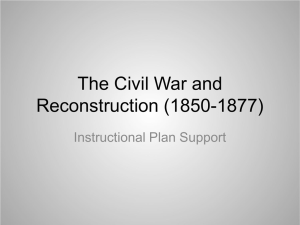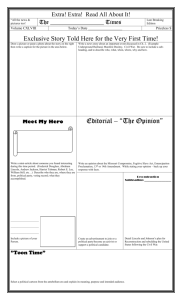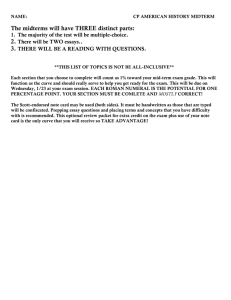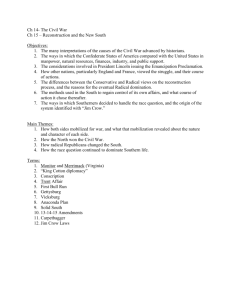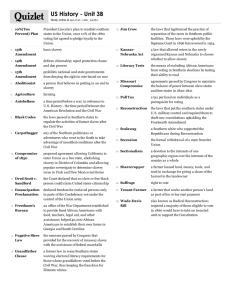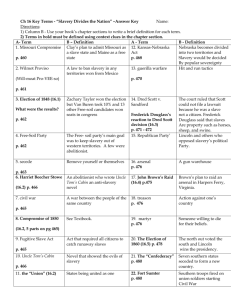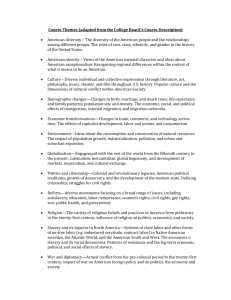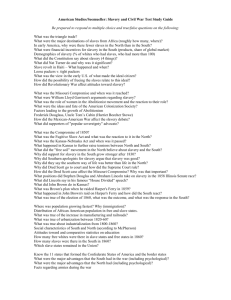Power Point notes - Time Traveler Productions
advertisement
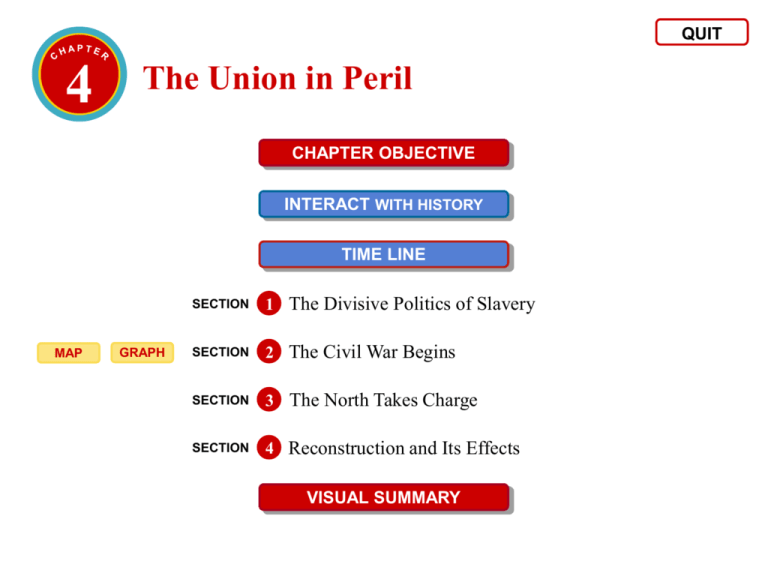
QUIT 4 The Union in Peril CHAPTER OBJECTIVE INTERACT WITH HISTORY TIME LINE MAP GRAPH SECTION 1 The Divisive Politics of Slavery SECTION 2 The Civil War Begins SECTION 3 The North Takes Charge SECTION 4 Reconstruction and Its Effects VISUAL SUMMARY HOME 4 The Union in Peril CHAPTER OBJECTIVE To understand the events that led to the Civil War, the course and outcome of the war, and the establishment and eventual failure of Reconstruction HOME 4 The Union in Peril INTERACT WITH HISTORY The year is 1850. Across the United States a debate is raging, dividing North from South: Is slavery a property right or is it a violation of liberty and human dignity? The future of the Union depends on compromise—but for many people on both sides, compromise is unacceptable. How can the Union be saved? Examine the Issues • Is it possible to compromise on an ethical issue such as slavery? • What are the obstacles to altering an institution, such as slavery, that is fundamental to a region’s economy and way of life? HOME 4 The Union in Peril TIME LINE The United States The World 1851 The Great Exhibition opens in London. 1852 Franklin Pierce is elected president. Uncle Tom’s Cabin published. 1854 Charles Dickens’s Hard Times is published. 1856 James Buchanan is elected president. 1857 The Supreme Court rules against Dred Scott. 1860 Abraham Lincoln wins presidential election. South Carolina secedes. 1861 The Confederacy is formed. Civil War begins. 1863 Battles of Gettysburg and Vicksburg. 1861 Russian serfs emancipated by Czar Alexander II. continued . . . HOME 4 The Union in Peril TIME LINE The United States The World 1864 Maximilian of Austria becomes emperor of Mexico. 1865 Civil War ends. Lincoln is assassinated; Andrew Johnson becomes president. 1868 Ulysses S. Grant is elected president. 1868 Cubans revolt against Spain. 1876 Rutherford B. Hayes is elected president. 1876 Japan forces Korea to open ports to trade. 1877 Reconstruction ends. HOME 1 The Divisive Politics of Slavery KEY IDEA The issue of slavery leads to increased tension and violence between the North and the South and finally brings the nation to the brink of war. OVERVIEW ASSESSMENT HOME 1 The Divisive Politics of Slavery OVERVIEW MAIN IDEA WHY IT MATTERS NOW Disagreements over slavery heightened regional tensions and led to the breakup of the Union. The modern Democratic and Republican parties emerged from the political tensions of the mid19th century. TERMS & NAMES • Harriet Tubman • Stephen Douglas • Harriet Beecher Stowe • Franklin Pierce • Abraham Lincoln • Underground Railroad • Jefferson Davis • Confederacy • popular sovereignty • Dred Scott • secession ASSESSMENT HOME 1 The Divisive Politics of Slavery ASSESSMENT 1. Look at the graphic to help organize your thoughts. List four events that heightened tensions between the North and South. Event One The Compromise of 1850 includes a new fugitive slave law Event Three 1857, Dred Scott Decision Supreme Court case causes sectional passions to explode Event Two 1852, Uncle Tom’s Cabin book on slavery stirs strong reactions Event Four 1859, John Brown attacks Harpers Ferry attempt to start a slave uprising intensifies sectional feeling in the country continued . . . 1 HOME The Divisive Politics of Slavery ASSESSMENT 2. Do you think there were any points at which civil war might have been averted? Think About: • the Compromise of 1850, the Fugitive Slave Act, and the Kansas-Nebraska Act • the new political parties • the Supreme Court’s ruling in the Dred Scott decision • the election of Abraham Lincoln as president in 1860 ANSWER POSSIBLE RESPONSES: • Yes. The Supreme Court made a major blunder in the Dred Scott decision. • No. The conflict was inevitable. continued . . . 1 HOME The Divisive Politics of Slavery ASSESSMENT 3. John Brown, Harriet Tubman, Harriet Beecher Stowe, and Stephen Douglas all opposed slavery. Who do you think had the greatest impact on American history and why? ANSWER Responses should reflect understanding of the strengths and weaknesses of each individual and an awareness of their contributions. continued . . . 1 HOME The Divisive Politics of Slavery ASSESSMENT 4. How did the tension between states’ rights and national government authority manifest itself in the events leading up to the Civil War? ANSWER Popular sovereignty reinforced states’ rights. The Dred Scott decision convinced many Northerners that the slave states were influencing the national government. Lincoln’s election frightened supporters of states’ rights, because he believed that Congress could abolish slavery. End of Section 1 MAP HOME GRAPH 2 The Civil War Begins KEY IDEA The Civil War becomes a more prolonged, deadly conflict than anyone had predicted and has a significant impact on civilians, soldiers, and African Americans. OVERVIEW ASSESSMENT MAP HOME GRAPH 2 The Civil War Begins OVERVIEW MAIN IDEA WHY IT MATTERS NOW Shortly after the nation’s Southern states seceded from the Union, war began between the North and South. The nation’s identity was forged in part by the Civil War. Sectional divisions remain very strong today. TERMS & NAMES • Fort Sumter • Bull Run • Emancipation Proclamation • Robert E. Lee • Antietam • Stonewall Jackson • Clara Barton • conscription • Ulysses S. Grant • income tax ASSESSMENT MAP HOME GRAPH 2 The Civil War Begins ASSESSMENT 1. Look at the graphic to help organize your thoughts. List the military actions and social and economic changes of the first two years of the Civil War. Military Actions Social & Economic Changes 1. Bull Run 1. African Americans join Union army 2. Shiloh 2. Food shortages in South 3. Antietam 3. Battlefield medicine 4. First income tax continued . . . MAP GRAPH 2 HOME The Civil War Begins ASSESSMENT 2. What effects did the Civil War have on women and African Americans? Think About: • the impact of the Emancipation Proclamation • women’s role in the war effort ANSWER Opportunities expanded for both groups. For example, the Emancipation Proclamation allowed African Americans to fight for the Union, and new jobs, such as nursing, opened to women. continued . . . MAP GRAPH 2 HOME The Civil War Begins ASSESSMENT 3. What advantages did the Union have over the South? ANSWER The Union had greater human resources, more factories, greater food production, and a more extensive railroad system. End of Section 2 HOME 3 The North Takes Charge KEY IDEA The South surrenders to the North. However, the war has an enduring effect on the nation and on American lives. OVERVIEW ASSESSMENT HOME 3 The North Takes Charge OVERVIEW MAIN IDEA WHY IT MATTERS NOW After four years of bloody fighting, the Union wore down the Confederacy and won the war. The Union victory confirmed the authority of the federal government over the states. TERMS & NAMES • Thirteenth Amendment • Gettysburg • William Tecumseh Sherman • Gettysburg Address • Vicksburg • Appomattox Court House • John Wilkes Booth ASSESSMENT HOME 3 The North Takes Charge ASSESSMENT 1. Look at the graphic to help organize your thoughts. List political, economic, physical, and social consequences of the Civil War. Freed enslaved people; prevented disintegration of Union Political Economic Consequences of the Civil War Physical Social Stimulated economic growth of the North and contributed to economic decline of the South Widespread destruction of houses, livestock, and railroads in the South; increased industrialization in the North Family life in both North and South disrupted by departure of millions of men to fight in the war and the high casualty rate continued . . . 3 HOME The North Takes Charge ASSESSMENT 2. Grant and Sherman used the strategy of total war. Do you think the end justifies the means? That is, did defeating the Confederacy justify harming civilians? Think About: • their reasons for targeting the civilian population • Sherman’s march through Georgia ANSWER POSSIBLE RESPONSES: • Yes. Saving the Union and abolishing slavery were worth the cost of civilian lives. • No. Killing defenseless citizens is immoral under any circumstances. continued . . . 3 HOME The North Takes Charge ASSESSMENT 3. How did Lincoln abolish slavery in all states? ANSWER Lincoln thought that a constitutional amendment would be necessary to abolish slavery, and the Thirteenth Amendment was passed at the end of 1865. continued . . . 3 HOME The North Takes Charge ASSESSMENT 4. Why did the Union’s victory strengthen the power of the national government? ANSWER It ensured that states would never again threaten secession. End of Section 3 HOME 4 Reconstruction and Its Effects KEY IDEA Reconstruction results in many political, social, and economic changes in the South before being ended in 1877. OVERVIEW ASSESSMENT HOME 4 Reconstruction and Its Effects OVERVIEW MAIN IDEA WHY IT MATTERS NOW After the Civil War, the nation embarked on a period known as Reconstruction, during which attempts were made to readmit the South to the Union. The Fourteenth and Fifteenth Amendments, passed as part of Reconstruction, gave civil rights to Americans of all races. TERMS & NAMES • Freedmen’s Bureau • Reconstruction • Fourteenth Amendment • Radical Republicans • scalawag • Fifteenth Amendment • Andrew Johnson • carpetbagger • Ku Klux Klan (KKK) • sharecropping • Hiram Revels ASSESSMENT HOME 4 Reconstruction and Its Effects ASSESSMENT 1. Look at the graphic to help organize your thoughts. List five problems facing the South after the Civil War. Then describe the solution that was attempted for each problem. Problem Attempted Solution Reuniting North and South Congressional Reconstruction Physical devastation of the South Public Works Programs Former slaves need assistance Freedmen’s Bureau established Former slaves need land 40 acres and a mule plan Vigilante groups arise Enforcement Acts continued . . . 4 HOME Reconstruction and Its Effects ASSESSMENT 2. Do you think that Reconstruction had positive effects on Southern society? Think About: • the formation of the Ku Klux Klan • why so many African Americans turned to sharecropping ANSWER POSSIBLE RESPONSES: • Reconstruction’s positive effects include the Freedmen’s Bureau’s assistance to former slaves. • Reconstruction had negative effects: by trying to help former slaves it encouraged a backlash that intensified racism and led to the rise of the Ku Klux Klan; by not offering land to former slaves, it forced African Americans into sharecropping. continued . . . 4 HOME Reconstruction and Its Effects ASSESSMENT 3. How did the Radical Republicans hope to reconstruct the South? ANSWER The Radical Republicans wanted to destroy the political power of former slaveholders. They also wanted African Americans to be given full citizenship, including the right to vote. End of Section 4

